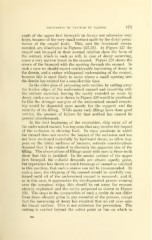Page 395 - My FlipBook
P. 395
EXCAVATION OF CAVITIES BY CLASSES. 173
angle of the upper first bicuspids in decays not otiierwise very
large, because of the very small contact made by the distal prom-
inence of the cuspid tooth. This, and the treatment recom-
mended, are illustrated in Figures 227-232. In Figure 227 the
cuspid and bicuspid in their normal relation show the form of
the contact, which is such as will, in case of decay occurring,
cause a very narrow break in the enamel. Figure 228 shows the
crown of the bicuspid with the opening through the enamel. In
such a case we should expect considerable burrowing of decay in
the dentin, and a rather widespread undermining of the enamel,
because this is most likely to occur where a small opening into
the dentin has existed for a considerable time.
In the older plan of preparing such cavities by cutting away
the frailer edges of the undermined enamel and removing only
the carious material, leaving the cavity rounded as made by
decay, such a cavity as is shown in Figure 229 would be produced.
In this the stronger margins of the undermined enamel remain-
ing would be depended upon mostly for the support and the
security of the filling. While many such fillings have done good
service, the amount of failure by that method has caused its
general abandonment.
In the first beginning of the excavation, chip away all of
the undermined enamel, leaving none that may receive the impact
of the occlusion in chewing food. In some positions in which
the enamel does not receive the impact of the occlusion and has
not been weakened materially by backward decay, as often hap-
pens on the labial surfaces of incisors, esthetic considerations
demand that it be retained to diminish the apparent size of the
filling. The observations of fillings made with care in these teeth
show that this is justified. In the mesial surface of the upper
first bicuspid, the esthetic demands are almost equally great,
but experience has shown so much breakage of enamel so retained
in this position, that such a course can not be recommended. In
such a case, the chipping of the enamel should be carefully con-
tinued until all of the undermined enamel is removed; and if,
as in this case, it approaches the developmental groove running
over the marginal ridge, this should be cut away for reasons
already explained, and the cavity prepared as shown in Figure
230. The steps in the preparation of such a cavity do not differ
from those ali'eady given in any essential of the process, except
that the burrowing of decay has required that we cut over onto
the buccal surface. This is not extension for prevention. The
cutting is carried beyond the safest point or line on which to
2Sa


